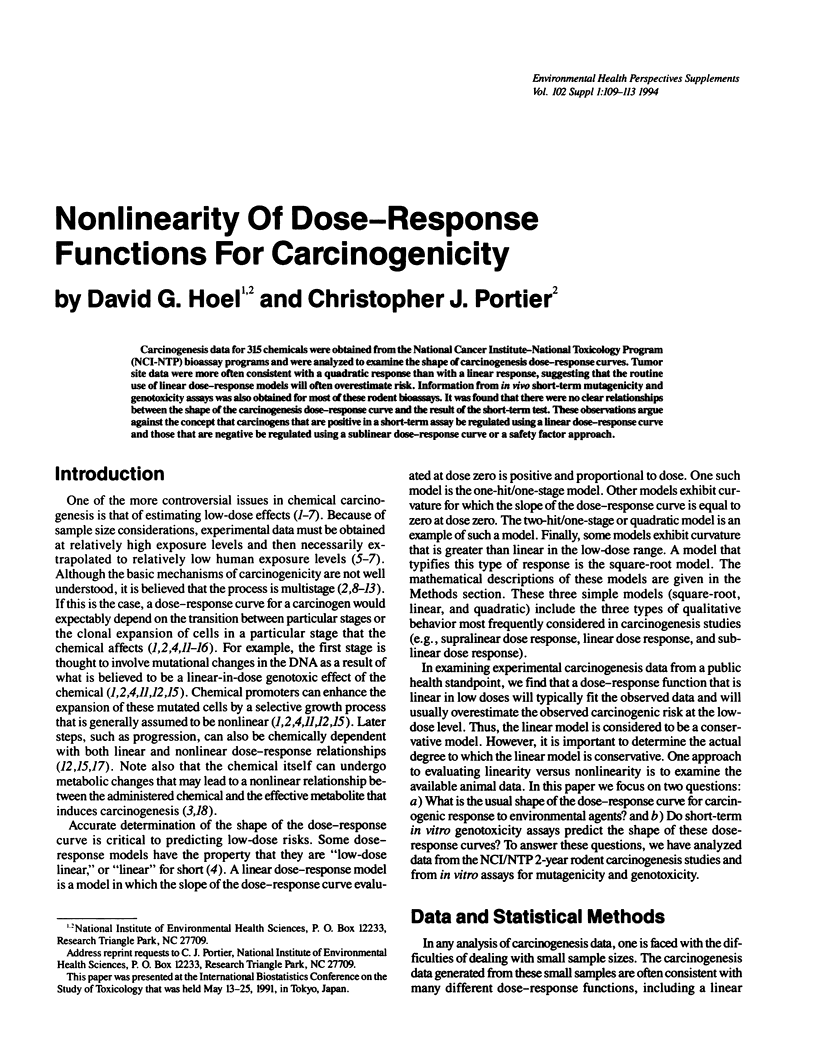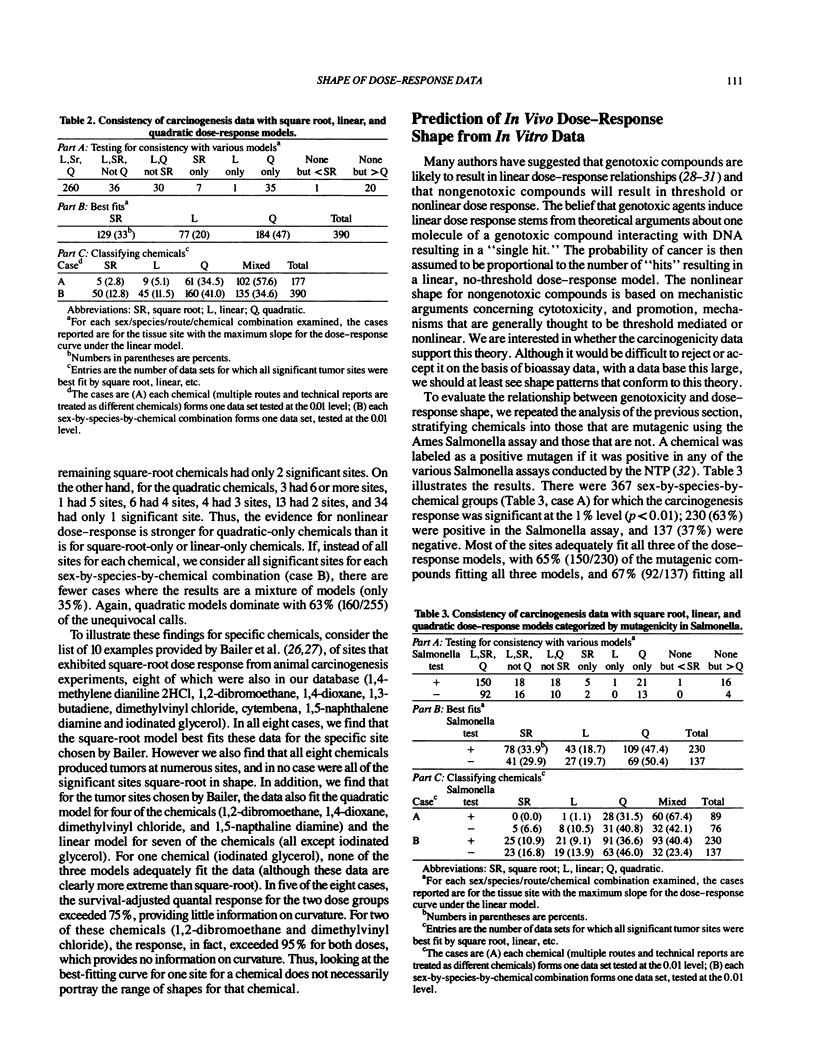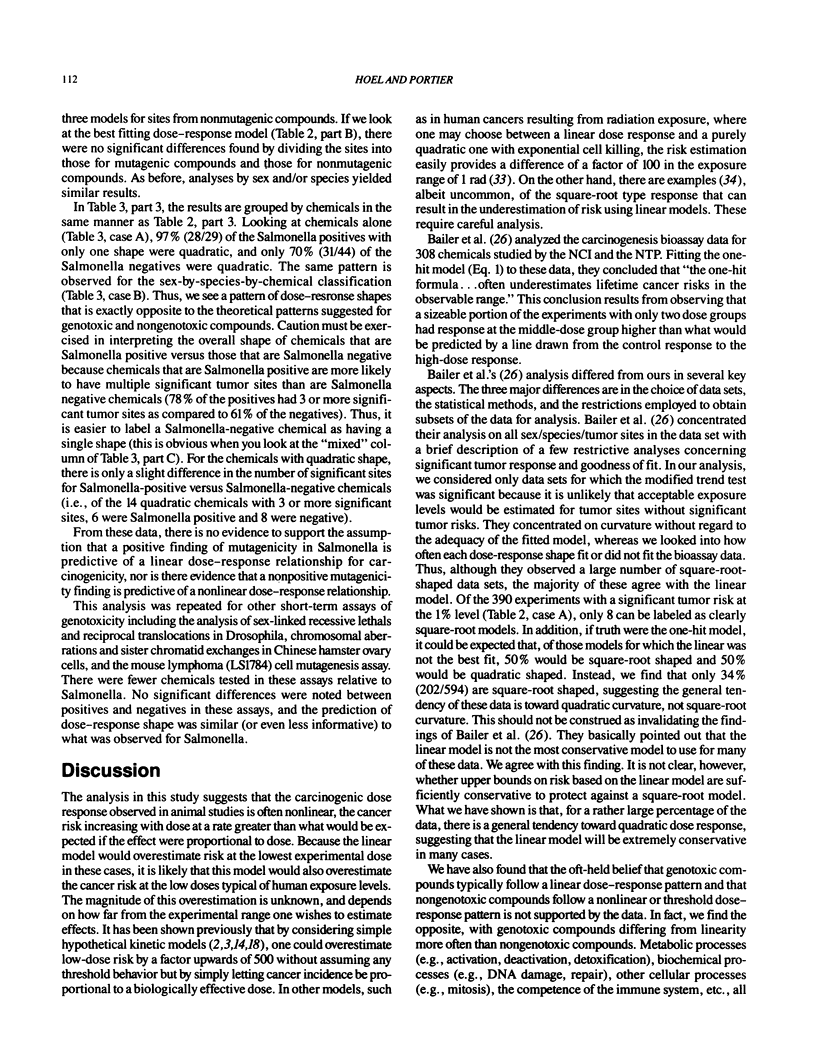Abstract
Carcinogenesis data for 315 chemicals were obtained from the National Cancer Institute-National Toxicology Program (NCI-NTP) bioassay programs and were analyzed to examine the shape of carcinogenesis dose-response curves. Tumor site data were more often consistent with a quadratic response than with a linear response, suggesting that the routine use of linear dose-response models will often overestimate risk. Information from in vivo short-term mutagenicity and genotoxicity assays was also obtained for most of these rodent bioassays. It was found that there were no clear relationships between the shape of the carcinogenesis dose-response curve and the result of the short-term test. These observations argue against the concept that carcinogens that are positive in a short-term assay be regulated using a linear dose-response curve and those that are negative be regulated using a sublinear dose-response curve or a safety factor approach.
Full text
PDF




Selected References
These references are in PubMed. This may not be the complete list of references from this article.
- Ames B. N., Gold L. S. Too many rodent carcinogens: mitogenesis increases mutagenesis. Science. 1990 Aug 31;249(4972):970–971. doi: 10.1126/science.2136249. [DOI] [PubMed] [Google Scholar]
- Andersen M. E., Clewell H. J., 3rd, Gargas M. L., Smith F. A., Reitz R. H. Physiologically based pharmacokinetics and the risk assessment process for methylene chloride. Toxicol Appl Pharmacol. 1987 Feb;87(2):185–205. doi: 10.1016/0041-008x(87)90281-x. [DOI] [PubMed] [Google Scholar]
- Bailar J. C., 3rd, Crouch E. A., Shaikh R., Spiegelman D. One-hit models of carcinogenesis: conservative or not? Risk Anal. 1988 Dec;8(4):485–497. doi: 10.1111/j.1539-6924.1988.tb01189.x. [DOI] [PubMed] [Google Scholar]
- Bailer A. J., Portier C. J. Effects of treatment-induced mortality and tumor-induced mortality on tests for carcinogenicity in small samples. Biometrics. 1988 Jun;44(2):417–431. [PubMed] [Google Scholar]
- Barrett J. C., Wiseman R. W. Cellular and molecular mechanisms of multistep carcinogenesis: relevance to carcinogen risk assessment. Environ Health Perspect. 1987 Dec;76:65–70. doi: 10.1289/ehp.877665. [DOI] [PMC free article] [PubMed] [Google Scholar]
- Belinsky S. A., White C. M., Devereux T. R., Swenberg J. A., Anderson M. W. Cell selective alkylation of DNA in rat lung following low dose exposure to the tobacco specific carcinogen 4-(N-methyl-N-nitrosamino)-1-(3-pyridyl)-1-butanone. Cancer Res. 1987 Feb 15;47(4):1143–1148. [PubMed] [Google Scholar]
- Bishop J. M. The molecular genetics of cancer. Science. 1987 Jan 16;235(4786):305–311. doi: 10.1126/science.3541204. [DOI] [PubMed] [Google Scholar]
- Burns F., Albert R., Altshuler B., Morris E. Approach to risk assessment for genotoxic carcinogens based on data from the mouse skin initiation-promotion model. Environ Health Perspect. 1983 Apr;50:309–320. doi: 10.1289/ehp.8350309. [DOI] [PMC free article] [PubMed] [Google Scholar]
- Cohen S. M., Ellwein L. B. Cell proliferation in carcinogenesis. Science. 1990 Aug 31;249(4972):1007–1011. doi: 10.1126/science.2204108. [DOI] [PubMed] [Google Scholar]
- Cornfield J. Carcinogenic risk assessment. Science. 1977 Nov 18;198(4318):693–699. doi: 10.1126/science.910152. [DOI] [PubMed] [Google Scholar]
- Gold L. S., Bernstein L., Kaldor J., Backman G., Hoel D. An empirical comparison of methods used to estimate carcinogenic potency in long-term animal bioassays: lifetable vs summary incidence data. Fundam Appl Toxicol. 1986 Feb;6(2):263–269. doi: 10.1016/0272-0590(86)90239-3. [DOI] [PubMed] [Google Scholar]
- Gough M. Science policy choices and the estimation of cancer risk associated with exposure to TCDD. Risk Anal. 1988 Sep;8(3):337–342. doi: 10.1111/j.1539-6924.1988.tb00496.x. [DOI] [PubMed] [Google Scholar]
- Hoel D. G., Kaplan N. L., Anderson M. W. Implication of nonlinear kinetics on risk estimation in carcinogenesis. Science. 1983 Mar 4;219(4588):1032–1037. doi: 10.1126/science.6823565. [DOI] [PubMed] [Google Scholar]
- Kroes R. Contribution of toxicology towards risk assessment of carcinogens. Arch Toxicol. 1987;60(1-3):224–228. doi: 10.1007/BF00296985. [DOI] [PubMed] [Google Scholar]
- Land H., Parada L. F., Weinberg R. A. Cellular oncogenes and multistep carcinogenesis. Science. 1983 Nov 18;222(4625):771–778. doi: 10.1126/science.6356358. [DOI] [PubMed] [Google Scholar]
- Mantel N., Schneiderman M. A. Estimating "safe" levels, a hazardous undertaking. Cancer Res. 1975 Jun;35(6):1379–1386. [PubMed] [Google Scholar]
- Moolgavkar S. H., Knudson A. G., Jr Mutation and cancer: a model for human carcinogenesis. J Natl Cancer Inst. 1981 Jun;66(6):1037–1052. doi: 10.1093/jnci/66.6.1037. [DOI] [PubMed] [Google Scholar]
- Newbold R. F., Overell R. W. Fibroblast immortality is a prerequisite for transformation by EJ c-Ha-ras oncogene. Nature. 1983 Aug 18;304(5927):648–651. doi: 10.1038/304648a0. [DOI] [PubMed] [Google Scholar]
- Perera F. P. The genotoxic/epigenetic distinction: relevance to cancer policy. Environ Res. 1984 Jun;34(1):175–191. doi: 10.1016/0013-9351(84)90087-2. [DOI] [PubMed] [Google Scholar]
- Portier C. J., Bailer A. J. Testing for increased carcinogenicity using a survival-adjusted quantal response test. Fundam Appl Toxicol. 1989 May;12(4):731–737. doi: 10.1016/0272-0590(89)90004-3. [DOI] [PubMed] [Google Scholar]
- Portier C. J., Kopp-Schneider A. A multistage model of carcinogenesis incorporating DNA damage and repair. Risk Anal. 1991 Sep;11(3):535–543. doi: 10.1111/j.1539-6924.1991.tb00639.x. [DOI] [PubMed] [Google Scholar]
- Roberts L. Is risk assessment conservative? Science. 1989 Mar 24;243(4898):1553–1553. doi: 10.1126/science.2928792. [DOI] [PubMed] [Google Scholar]
- Slaga T. J., Fischer S. M., Nelson K., Gleason G. L. Studies on the mechanism of skin tumor promotion: evidence for several stages in promotion. Proc Natl Acad Sci U S A. 1980 Jun;77(6):3659–3663. doi: 10.1073/pnas.77.6.3659. [DOI] [PMC free article] [PubMed] [Google Scholar]
- Weinberg R. A. Negative growth controls and carcinogenesis. Mol Carcinog. 1990;3(1):3–4. doi: 10.1002/mc.2940030103. [DOI] [PubMed] [Google Scholar]
- Weinberg R. A. The action of oncogenes in the cytoplasm and nucleus. Science. 1985 Nov 15;230(4727):770–776. doi: 10.1126/science.2997917. [DOI] [PubMed] [Google Scholar]
- Weisburger J. H., Williams G. M. Carcinogen testing: current problems and new approaches. Science. 1981 Oct 23;214(4519):401–407. doi: 10.1126/science.7291981. [DOI] [PubMed] [Google Scholar]


